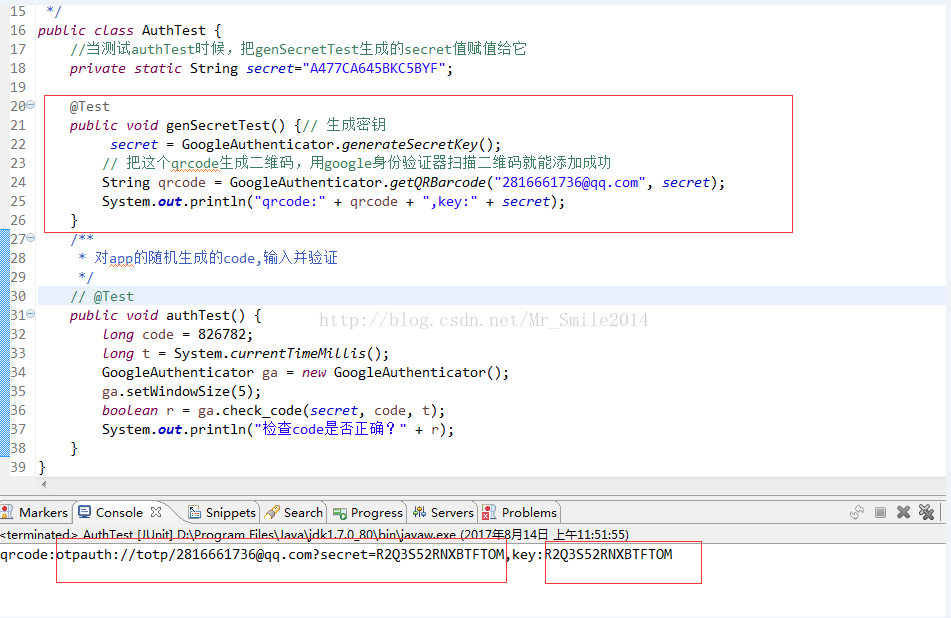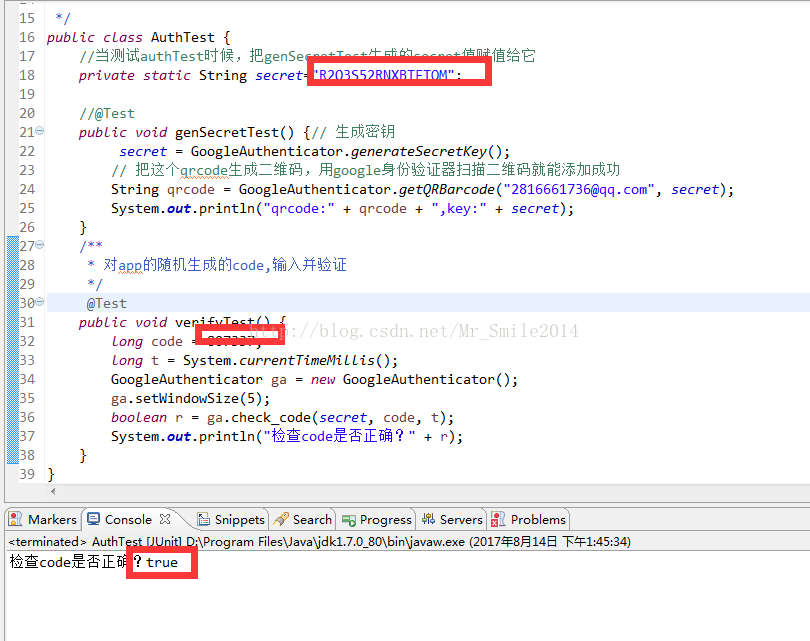- ubuntu12.04环境下使用kvm ioctl接口实现最简单的虚拟机
- Ubuntu 通过无线网络安装Ubuntu Server启动系统后连接无线网络的方法
- 在Ubuntu上搭建网桥的方法
- ubuntu 虚拟机上网方式及相关配置详解
CFSDN坚持开源创造价值,我们致力于搭建一个资源共享平台,让每一个IT人在这里找到属于你的精彩世界.
这篇CFSDN的博客文章java使用google身份验证器实现动态口令验证的示例由作者收集整理,如果你对这篇文章有兴趣,记得点赞哟.
最近有用户反应我们现有的短信+邮件验证,不安全及短信条数限制和邮件收验证码比较慢的问题,希望我们也能做一个类似银行动态口令的验证方式。经过对可行性的分析及慎重考虑,可以实现一个这样的功能.
怎么实现呢,是自己开发一个这样的app?这样成本太高了,为了节约成本,我们使用互联网使用比较多的google身份验证器。使用它,我们只需要开发服务端就可以了.
google身份验证器的原理是什么呢?客户端和服务器事先协商好一个密钥k,用于一次性密码的生成过程,此密钥不被任何第三方所知道。此外,客户端和服务器各有一个计数器c,并且事先将计数值同步。进行验证时,客户端对密钥和计数器的组合(k,c)使用hmac(hash-based message authentication code)算法计算一次性密码,公式如下:
|
1
|
|
|
hotp(k,c) = truncate(hmac-sha-
1
(k,c))
|
上面采用了hmac-sha-1,当然也可以使用hmac-md5等。hmac算法得出的值位数比较多,不方便用户输入,因 此需要截断(truncate)成为一组不太长十进制数(例如6位)。计算完成之后客户端计数器c计数值加1。用户将这一组十 进制数输入并且提交之后,服务器端同样的计算,并且与用户提交的数值比较,如果相同,则验证通过,服务器端将计数值 c增加1。如果不相同,则验证失败.
|
1
|
|
2
3
4
5
6
7
8
9
10
11
12
13
14
15
16
17
18
19
20
21
22
23
24
25
26
27
28
29
30
31
32
33
34
35
36
37
38
39
40
41
42
43
44
45
46
47
48
49
50
51
52
53
54
55
56
57
58
59
60
61
62
63
64
65
66
67
68
69
70
71
72
73
74
75
76
77
78
79
80
81
82
83
84
85
86
87
88
89
90
91
92
93
94
95
96
97
98
99
100
101
102
103
104
105
106
107
108
109
110
111
112
113
114
115
116
117
118
119
120
121
122
123
124
125
126
127
128
129
130
131
132
133
134
135
136
137
138
139
140
141
142
143
144
145
146
147
148
149
150
151
152
153
154
155
156
157
158
159
160
161
162
163
164
165
|
package
com.auth.google;
import
java.security.invalidkeyexception;
import
java.security.nosuchalgorithmexception;
import
java.security.securerandom;
import
javax.crypto.mac;
import
javax.crypto.spec.secretkeyspec;
import
org.apache.commons.codec.binary.base32;
import
org.apache.commons.codec.binary.base64;
/**
*
*
* google身份验证器,java服务端实现
*
* @author yangbo
*
* @version 创建时间:2017年8月14日 上午10:10:02
*
*
*/
public
class
googleauthenticator {
// 生成的key长度( generate secret key length)
public
static
final
int
secret_size =
10
;
public
static
final
string seed =
"g8gjevtbw5ovsv7avl47357438reyhreyuryetredldvks2m0qn7vxrs2im5mdancwgmcd2rvczx"
;
// java实现随机数算法
public
static
final
string random_number_algorithm =
"sha1prng"
;
// 最多可偏移的时间
int
window_size =
3
;
// default 3 - max 17
/**
* set the windows size. this is an integer value representing the number of
* 30 second windows we allow the bigger the window, the more tolerant of
* clock skew we are.
*
* @param s
* window size - must be >=1 and <=17. other values are ignored
*/
public
void
setwindowsize(
int
s) {
if
(s >=
1
&& s <=
17
)
window_size = s;
}
/**
* generate a random secret key. this must be saved by the server and
* associated with the users account to verify the code displayed by google
* authenticator. the user must register this secret on their device.
* 生成一个随机秘钥
*
* @return secret key
*/
public
static
string generatesecretkey() {
securerandom sr =
null
;
try
{
sr = securerandom.getinstance(random_number_algorithm);
sr.setseed(base64.decodebase64(seed));
byte
[] buffer = sr.generateseed(secret_size);
base32 codec =
new
base32();
byte
[] bencodedkey = codec.encode(buffer);
string encodedkey =
new
string(bencodedkey);
return
encodedkey;
}
catch
(nosuchalgorithmexception e) {
// should never occur... configuration error
}
return
null
;
}
/**
* return a url that generates and displays a qr barcode. the user scans
* this bar code with the google authenticator application on their
* smartphone to register the auth code. they can also manually enter the
* secret if desired
*
* @param user
* user id (e.g. fflinstone)
* @param host
* host or system that the code is for (e.g. myapp.com)
* @param secret
* the secret that was previously generated for this user
* @return the url for the qr code to scan
*/
public
static
string getqrbarcodeurl(string user, string host, string secret) {
string format =
"
http://www.google.com/chart?chs=200x200&chld=m%%7c0&cht=qr&chl=otpauth://totp/%s@%s?secret=%s
"
;
return
string.format(format, user, host, secret);
}
/**
* 生成一个google身份验证器,识别的字符串,只需要把该方法返回值生成二维码扫描就可以了。
*
* @param user
* 账号
* @param secret
* 密钥
* @return
*/
public
static
string getqrbarcode(string user, string secret) {
string format =
"
otpauth://totp/%s?secret=%s
"
;
return
string.format(format, user, secret);
}
/**
* check the code entered by the user to see if it is valid 验证code是否合法
*
* @param secret
* the users secret.
* @param code
* the code displayed on the users device
* @param t
* the time in msec (system.currenttimemillis() for example)
* @return
*/
public
boolean
check_code(string secret,
long
code,
long
timemsec) {
base32 codec =
new
base32();
byte
[] decodedkey = codec.decode(secret);
// convert unix msec time into a 30 second "window"
// this is per the totp spec (see the rfc for details)
long
t = (timemsec / 1000l) / 30l;
// window is used to check codes generated in the near past.
// you can use this value to tune how far you're willing to go.
for
(
int
i = -window_size; i <= window_size; ++i) {
long
hash;
try
{
hash = verify_code(decodedkey, t + i);
}
catch
(exception e) {
// yes, this is bad form - but
// the exceptions thrown would be rare and a static
// configuration problem
e.printstacktrace();
throw
new
runtimeexception(e.getmessage());
// return false;
}
if
(hash == code) {
return
true
;
}
}
// the validation code is invalid.
return
false
;
}
private
static
int
verify_code(
byte
[] key,
long
t)
throws
nosuchalgorithmexception, invalidkeyexception {
byte
[] data =
new
byte
[
8
];
long
value = t;
for
(
int
i =
8
; i-- >
0
; value >>>=
8
) {
data[i] = (
byte
) value;
}
secretkeyspec signkey =
new
secretkeyspec(key,
"hmacsha1"
);
mac mac = mac.getinstance(
"hmacsha1"
);
mac.init(signkey);
byte
[] hash = mac.dofinal(data);
int
offset = hash[
20
-
1
] &
0xf
;
// we're using a long because java hasn't got unsigned int.
long
truncatedhash =
0
;
for
(
int
i =
0
; i <
4
; ++i) {
truncatedhash <<=
8
;
// we are dealing with signed bytes:
// we just keep the first byte.
truncatedhash |= (hash[offset + i] &
0xff
);
}
truncatedhash &=
0x7fffffff
;
truncatedhash %=
1000000
;
return
(
int
) truncatedhash;
}
}
|
测试代码:
|
1
|
|
2
3
4
5
6
7
8
9
10
11
12
13
14
15
16
17
18
19
20
21
22
23
24
25
26
27
28
29
30
31
32
33
34
35
36
37
38
39
|
package
com.auth.google;
import
org.junit.test;
/**
*
*
* 身份认证测试
*
* @author yangbo
*
* @version 创建时间:2017年8月14日 上午11:09:23
*
*
*/
public
class
authtest {
//当测试authtest时候,把gensecrettest生成的secret值赋值给它
private
static
string secret=
"r2q3s52rnxbtftom"
;
//@test
public
void
gensecrettest() {
// 生成密钥
secret = googleauthenticator.generatesecretkey();
// 把这个qrcode生成二维码,用google身份验证器扫描二维码就能添加成功
string qrcode = googleauthenticator.getqrbarcode(
"2816661736@qq.com"
, secret);
system.out.println(
"qrcode:"
+ qrcode +
",key:"
+ secret);
}
/**
* 对app的随机生成的code,输入并验证
*/
@test
public
void
verifytest() {
long
code =
807337
;
long
t = system.currenttimemillis();
googleauthenticator ga =
new
googleauthenticator();
ga.setwindowsize(
5
);
boolean
r = ga.check_code(secret, code, t);
system.out.println(
"检查code是否正确?"
+ r);
}
}
|
具体使用方式(ios演示):
第一步:进入iphone的appstore,在搜索框中输入google身份验证器,如下图:

选择上图中的google authenticator 并安装.
第二步:运行下面链接中下载的demo中的authtest的gensecrettest方法,控制台打印的结果如下图:

key:为app与服务端约定的秘钥,用于双方的认证.
qrcode:是app扫码能够识别的就是二维码值,把它生成二维码如下图:

第三步:打开google authenticator app软件选择扫描条形码按扭打开相机对二维码扫描加入账号,如下图:

第四步:把app中的数字,在authtest的verifytest进行验证,如下图:

通过上面给大家分享了google身份认证器服务端key的生成和它生成的随机密码的验证.
上面使用的代码已上传到码云,下载地址:googleauth.rar 。
以上就是本文的全部内容,希望对大家的学习有所帮助,也希望大家多多支持我.
原文链接:http://blog.csdn.net/mr_smile2014/article/details/77160873 。
最后此篇关于java使用google身份验证器实现动态口令验证的示例的文章就讲到这里了,如果你想了解更多关于java使用google身份验证器实现动态口令验证的示例的内容请搜索CFSDN的文章或继续浏览相关文章,希望大家以后支持我的博客! 。
背景: 我最近一直在使用 JPA,我为相当大的关系数据库项目生成持久层的轻松程度给我留下了深刻的印象。 我们公司使用大量非 SQL 数据库,特别是面向列的数据库。我对可能对这些数据库使用 JPA 有一
我已经在我的 maven pom 中添加了这些构建配置,因为我希望将 Apache Solr 依赖项与 Jar 捆绑在一起。否则我得到了 SolarServerException: ClassNotF
interface ITurtle { void Fight(); void EatPizza(); } interface ILeonardo : ITurtle {
我希望可用于 Java 的对象/关系映射 (ORM) 工具之一能够满足这些要求: 使用 JPA 或 native SQL 查询获取大量行并将其作为实体对象返回。 允许在行(实体)中进行迭代,并在对当前
好像没有,因为我有实现From for 的代码, 我可以转换 A到 B与 .into() , 但同样的事情不适用于 Vec .into()一个Vec . 要么我搞砸了阻止实现派生的事情,要么这不应该发
在 C# 中,如果 A 实现 IX 并且 B 继承自 A ,是否必然遵循 B 实现 IX?如果是,是因为 LSP 吗?之间有什么区别吗: 1. Interface IX; Class A : IX;
就目前而言,这个问题不适合我们的问答形式。我们希望答案得到事实、引用资料或专业知识的支持,但这个问题可能会引发辩论、争论、投票或扩展讨论。如果您觉得这个问题可以改进并可能重新打开,visit the
我正在阅读标准haskell库的(^)的实现代码: (^) :: (Num a, Integral b) => a -> b -> a x0 ^ y0 | y0 a -> b ->a expo x0
我将把国际象棋游戏表示为 C++ 结构。我认为,最好的选择是树结构(因为在每个深度我们都有几个可能的移动)。 这是一个好的方法吗? struct TreeElement{ SomeMoveType
我正在为用户名数据库实现字符串匹配算法。我的方法采用现有的用户名数据库和用户想要的新用户名,然后检查用户名是否已被占用。如果采用该方法,则该方法应该返回带有数据库中未采用的数字的用户名。 例子: “贾
我正在尝试实现 Breadth-first search algorithm , 为了找到两个顶点之间的最短距离。我开发了一个 Queue 对象来保存和检索对象,并且我有一个二维数组来保存两个给定顶点
我目前正在 ika 中开发我的 Python 游戏,它使用 python 2.5 我决定为 AI 使用 A* 寻路。然而,我发现它对我的需要来说太慢了(3-4 个敌人可能会落后于游戏,但我想供应 4-
我正在寻找 Kademlia 的开源实现C/C++ 中的分布式哈希表。它必须是轻量级和跨平台的(win/linux/mac)。 它必须能够将信息发布到 DHT 并检索它。 最佳答案 OpenDHT是
我在一本书中读到这一行:-“当我们要求 C++ 实现运行程序时,它会通过调用此函数来实现。” 而且我想知道“C++ 实现”是什么意思或具体是什么。帮忙!? 最佳答案 “C++ 实现”是指编译器加上链接
我正在尝试使用分支定界的 C++ 实现这个背包问题。此网站上有一个 Java 版本:Implementing branch and bound for knapsack 我试图让我的 C++ 版本打印
在很多情况下,我需要在 C# 中访问合适的哈希算法,从重写 GetHashCode 到对数据执行快速比较/查找。 我发现 FNV 哈希是一种非常简单/好/快速的哈希算法。但是,我从未见过 C# 实现的
目录 LRU缓存替换策略 核心思想 不适用场景 算法基本实现 算法优化
1. 绪论 在前面文章中提到 空间直角坐标系相互转换 ,测绘坐标转换时,一般涉及到的情况是:两个直角坐标系的小角度转换。这个就是我们经常在测绘数据处理中,WGS-84坐标系、54北京坐标系
在软件开发过程中,有时候我们需要定时地检查数据库中的数据,并在发现新增数据时触发一个动作。为了实现这个需求,我们在 .Net 7 下进行一次简单的演示. PeriodicTimer .
二分查找 二分查找算法,说白了就是在有序的数组里面给予一个存在数组里面的值key,然后将其先和数组中间的比较,如果key大于中间值,进行下一次mid后面的比较,直到找到相等的,就可以得到它的位置。

我是一名优秀的程序员,十分优秀!